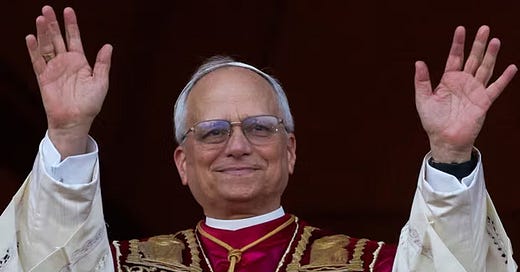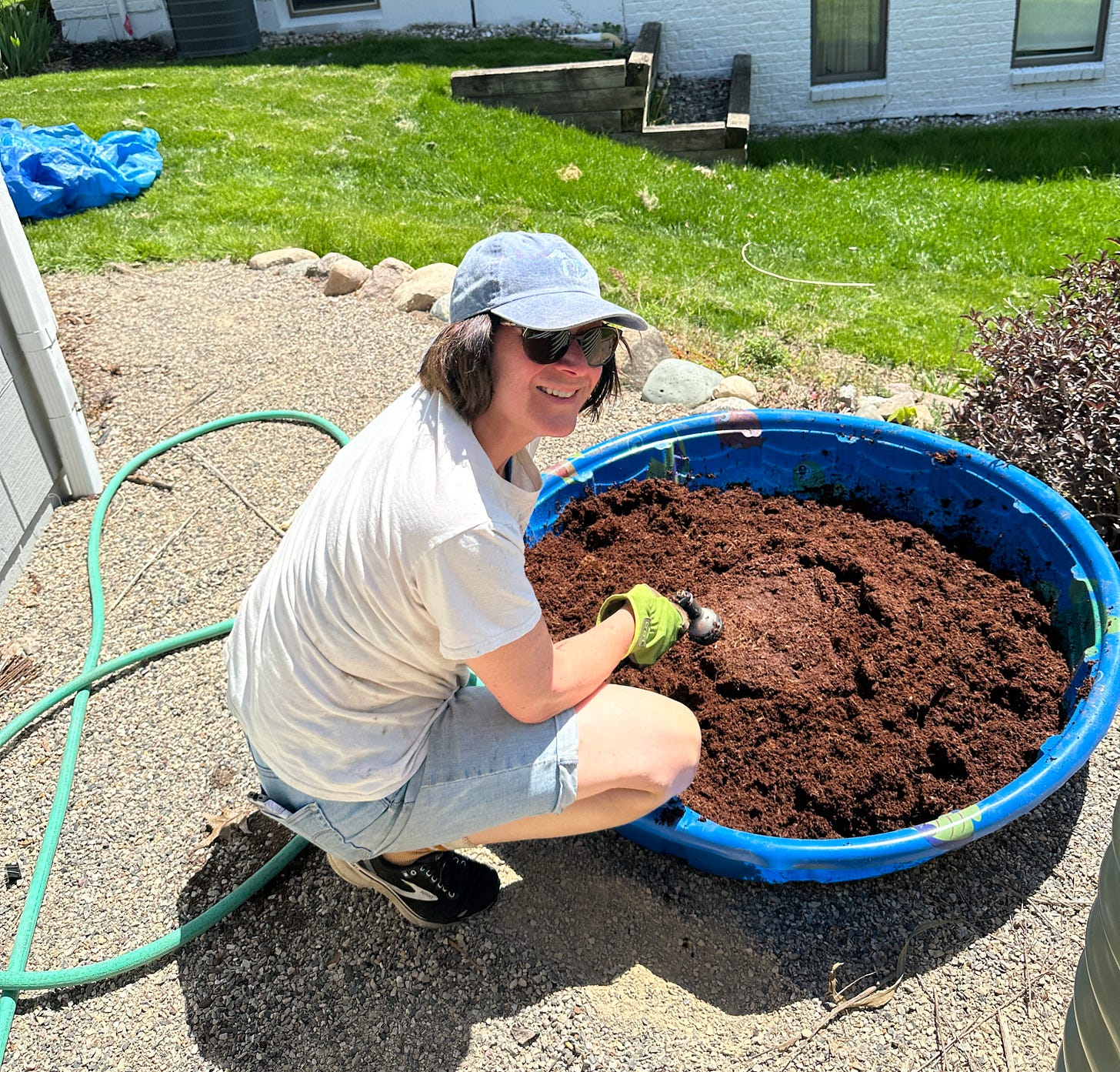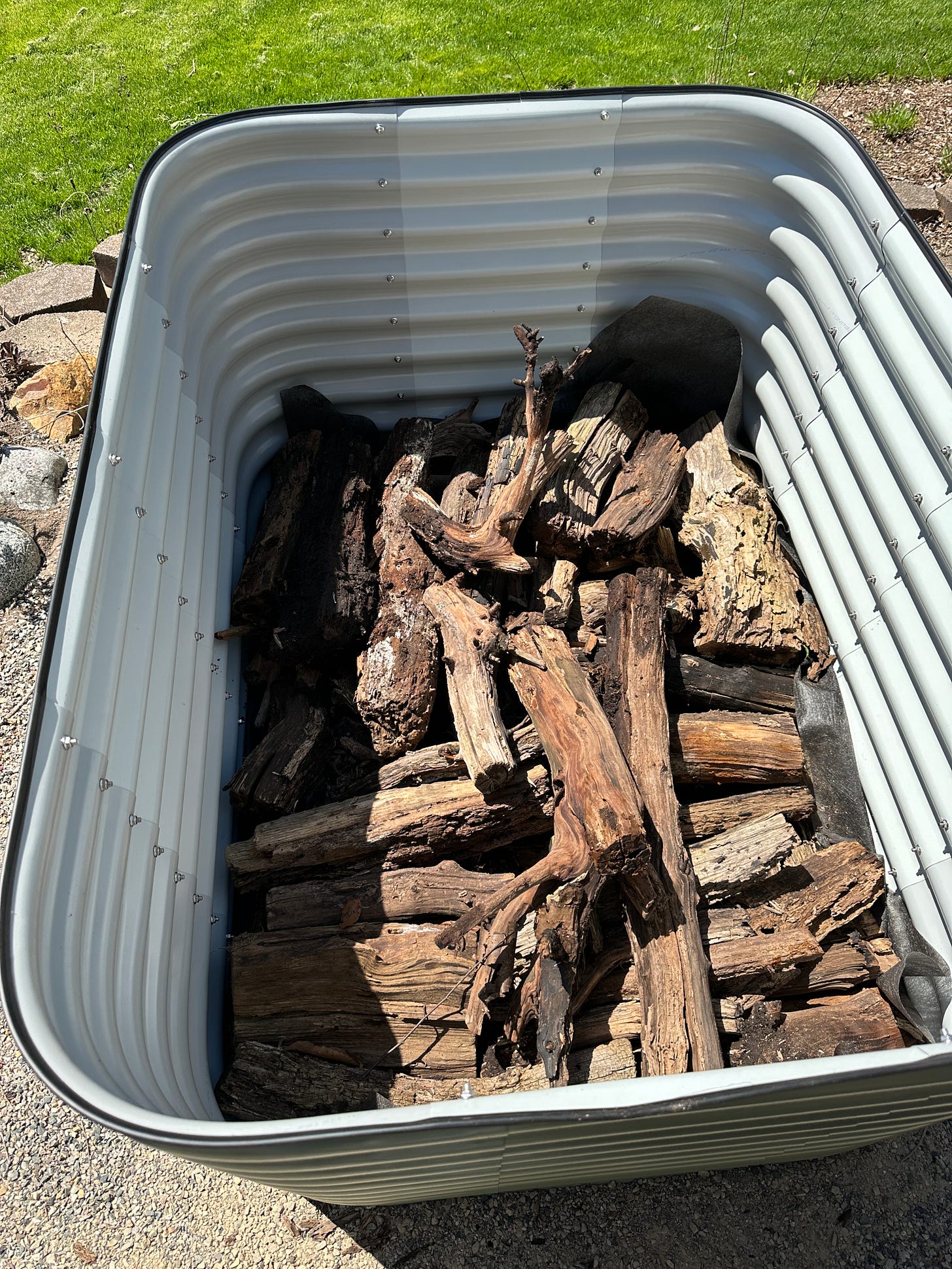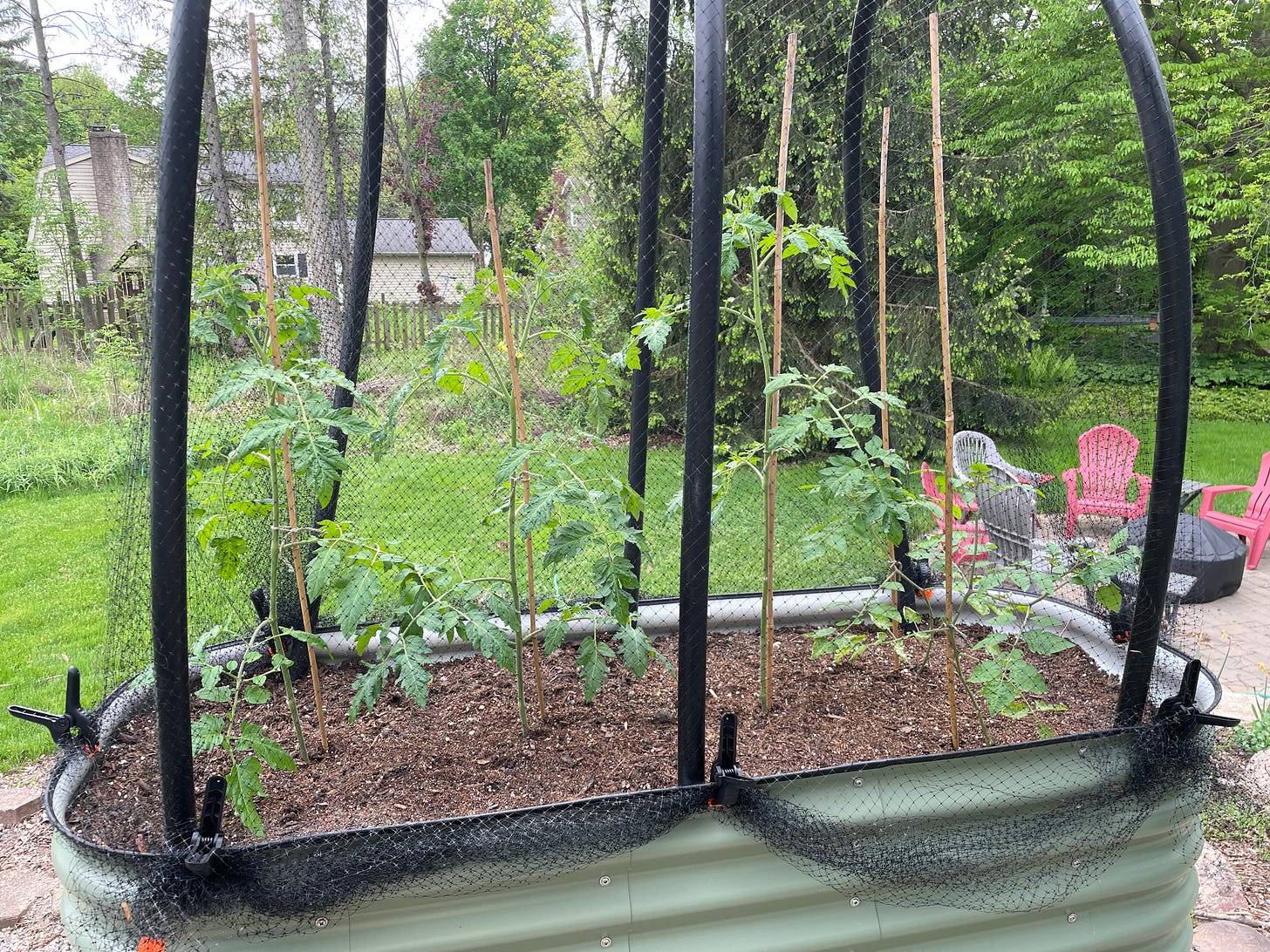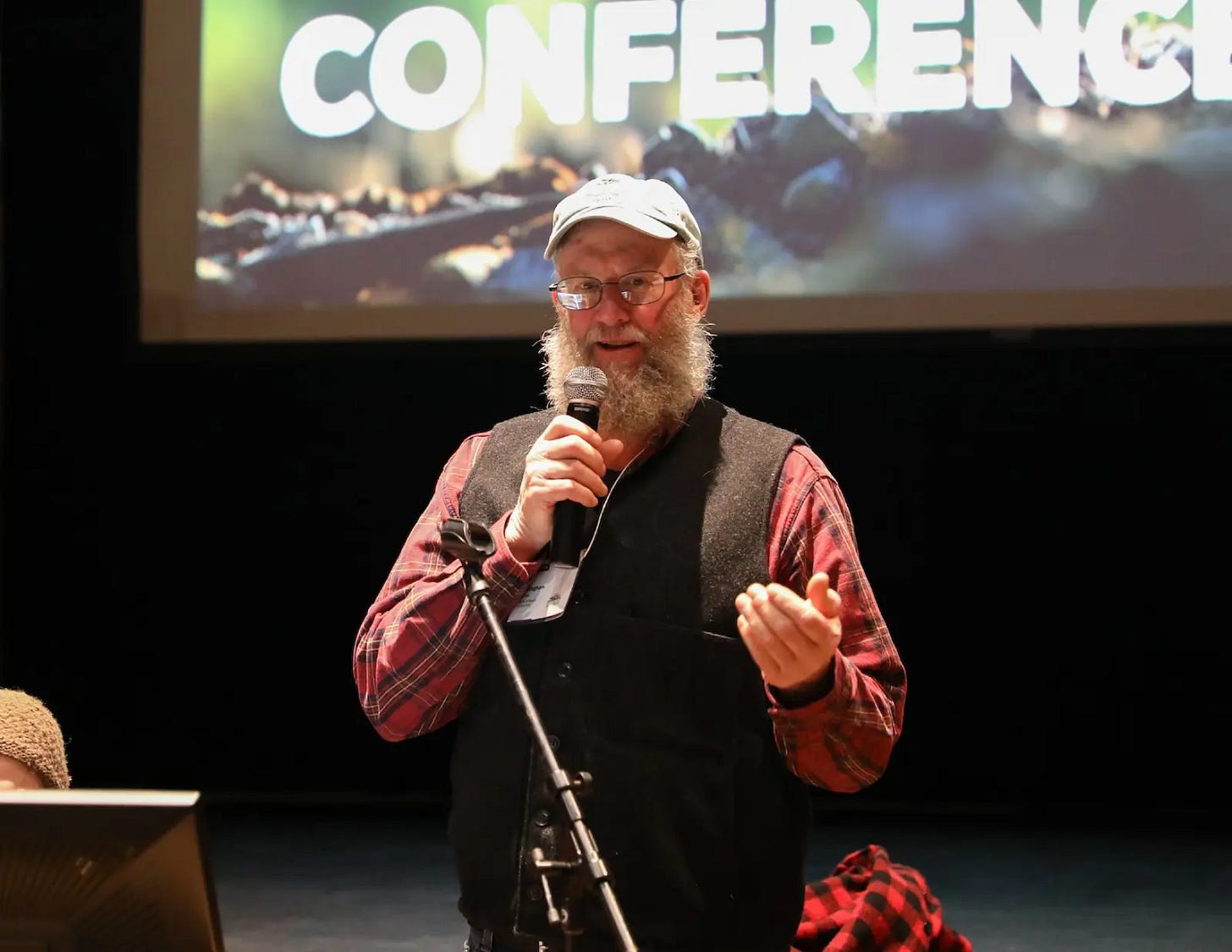Refugia Newsletter #93
Pope Leo XIV and climate, stalwart scientists, businesses doing good climate work (and not), whooping cranes, and yet more beavers
Refugia News
I turned in my semester grades this week, so… whew! Another academic year on the books. This was my twenty-ninth year of teaching. Hard to fathom. I’m definitely one of those grizzled, old-guard faculty now.
While trying to finish grades, spouse Ron and I were also scrambling to get these new raised beds built and filled. I had seed starts that were ready to go in! Just another hare-brained and ill-timed scheme from Ron and Deb. We will now have tomatoes worth an estimated $32 each in infrastructure investment costs.
This is what academics do at the end of the year: mix up huge batches of raised bed soil.
We filled the bottom of the beds hugelkultur-style. We also said the word “hugelkultur” with our bad German accents about a million times.
Do these black cherry tomato plants look happy? They’d better be!
Here’s my big news: Refugia Church is coming! Fortress Press offered me a contract this week! We’re looking at a release date in fall of 2026. I’m delighted to work with Fortress again, as they did such a beautiful job with Refugia Faith. I have tons of material gathered for the new book. Now I just have to … um … write it.
Thankfully, Ron is providing crucial research help, especially in his areas of expertise (worship, preaching, liturgy, ritual). And to help ground the book, we’re working on another season of the Refugia Podcast, interviewing churches and faith orgs about their climate work.
This weekend, in fact, we’re traveling (thank you, grant money!) to Baltimore and DC to interview two innovative people about their work. I’ll report in a future newsletter.
This Week in Climate News
We have a new pope! Early signs indicate that Cardinal Robert Francis Prevost, now Pope Leo XIV, is good news for faith and climate work. Pope Francis, as you know, was an emphatic defender of the poor and of the earth. He became an influential world leader for all people of conscience, whatever their faith commitments. Will the new pope continue in that role?
It seems: yes. It’s been fun to watch people scour the new pope’s speeches and social media for clues about the approach he will take to his role. (Also fun to watch all the “pope’s a Midwesterner” shenanigans.) Because Pope Leo is the first American pope—Chicago-born, but with long experience and dual-citizenship in Peru—people are calling him the “Latin Yankee.” What are environmentalists across the world predicting for his papacy? Brian Roewe writes for the National Catholic Reporter:
Even with few details, environmentalists both within and outside the Catholic Church seem optimistic based on what they have learned so far about Cardinal Robert Francis Prevost, the Augustinian friar and first successor to St. Peter from the United States.
Choosing the name Leo signals that the new pope sees himself in the tradition of Catholic “social doctrine,” which promotes an emphasis on justice, especially for the poor, a tradition that Pope Francis emphasized. The new pope has said that our relationship to our “common home” (a Pope Francis phrase) should not be “tyrannical” but one of “reciprocity.” He recently spoke of the need to move “from words to action” to protect the world’s most vulnerable people from climate impacts.
Pope Leo XIV. Image credit: Andrew Medichini/AP
Roewe cites another clue to Leo’s commitments in his early support for Laudato si’:
In 2015, in the run-up to the United Nations climate summit in Paris, Prevost tweeted in all caps "SIGN THE CLIMATE PETITION" and included a link to the petition organized by Laudato Si' Movement (then the Global Catholic Climate Movement) to collect 1 million Catholic signatures in support of a global climate deal that became the Paris Agreement.
(Here’s another short piece in Fast Company about the new pope.)
Also, and not unrelatedly, you may have read about how Cardinal Prevost’s social media account recently came after JD Vance’s statement in which Vance used the so-called “order of loves” or “ordo amoris” to give specious religious cover for cruel immigration policies. Cardinal Prevost’s post stated that Vance was simply wrong and cited an article explaining why. This piece by Lisa Lerer in the New York Times gives the details on what sorts of things Prevost’s account typically posted about. It seems at least that the new pope is willing to speak out against the current US federal regime, which (one can hope!) may help move US White Catholics away from their tendency to support Trump.
And now, two pieces on wins for science in the face of losses for science.
Ugh, I’m so disheartened by the gutting of federal science funding and initiatives. Even though I’m a humanities gal, I’m seeing the ripple effects among so many science folks I know. The malice and ignorance behind these cuts make it all so horrible. And yet: scientists are finding ways to band together and move forward. They’re trying to do good science anyway, because they understand: good science matters to people’s lives.
One example: doing the National Climate Assessment work anyway. Kiley Price of Inside Climate News reports:
Less than a week after volunteer researchers who were working on the congressionally mandated National Climate Assessment were dismissed from compiling it, the American Geophysical Union and American Meteorological Society pledged to offer a new home for the work. Meanwhile, scientists who were compiling the first-ever government National Nature Assessment have banded together to finish it.
Similar efforts are happening across the country to fill in the gaps left by federal research rollbacks. But experts say taxpayers are entitled to climate research that can help them make more informed decisions as mounting disasters upend daily life.
The National Climate Assessment was first ordered by Congress in 1990. This was to be the sixth report, due in 2028. Scientific associations are now worried that the federal government will indeed release a report in 2028 based on “junk science.” So they’re creating a new home for data and for scientific research-sharing related to climate. The National Nature Assessment, meanwhile, was first ordered by Pres. Biden in 2022. When it was cancelled in January, researchers found funding to continue the work and release a report next year.
Wes Gillingham, board president of the Northeast Organic Farming Association of New York (NOFA-NY). Not to stereotype, but if I met Mr. Gillingham on the street, I would not be surprised to learn he is an organic farmer. Image credit: NOFA-NY via this article in Grist on this story.
Taxpayers are entitled to accurate weather and climate data, too—and for farmers, this information is especially crucial. Which is why the Northeast Organic Farming Association of New York and environmental partners sued the USDA for purging the government website of climate data. And they won!
Karen Zraick reports for the New York Times:
The lawsuit, filed in February, said the purge denied farmers information to make time-sensitive decisions while facing business risks linked to climate change, such as heat waves, droughts, floods and wildfires. …
The plaintiffs had sought a court order requiring the department to restore the deleted pages. On Monday, the government said it would oblige.
The information is already coming back online and will supposedly be restored in a couple weeks. These battles are worth fighting: it’s possible to win!
Speaking of fighting: here’s your action suggestion for this week. Read this article from Canary Media on how state Republican lawmakers are figuring out that solar, including community solar, is actually good for their states. Then call your state reps (Dems or GOP) and tell them you support more solar in your state. Then call your federal reps and tell them to protect all the IRA clean energy incentives in the ongoing federal budget fights.
Deeper Dive
I’ve been thinking about the crucial role of businesses in counteracting the destructive and inept policies coming out of Washington. Businesses can continue to move forward on clean energy, sustainability, biodiversity, and conservation support. So we’re going to do a “good business/bad business” rundown. Hmm. A good/bad dichotomy is a little too simplistic, eh? So let’s just say: businesses doing good things/businesses doing bad things.
GOOD THINGS
First, some good things. Did you know the vast majority of business leaders globally want a clean energy transition? Yes. This article has all the details and a link to the actual study. Here’s the summary:
Business voices have expressed overwhelming support for the transition to renewable electricity. They have backed moving away from fossil fuels and are calling on governments to remove the barriers to achieving a rapid transition. Business leaders globally recognise that energy security, economic growth, and long-term competitiveness depend on a renewables based power system.
Next, a Michigan-based, modular EV truck startup. I don’t love that Jeff Bezos is a major investor. But I do love that the Slate company (as in, a blank slate) is run by a woman CEO and is making affordable, American-made EVs. They’re simple, small, and customizable.
This is the no-frills base model. The idea is to zazz your version up with your personal selection of color, shape, and frills options.
Bill Gates will give away all his wealth by 2045. Ever wonder if billionaires ever do anything useful? Well, whatever you think of Bill Gates, he has now decided to give away even more money faster. He writes:
I will give away virtually all my wealth through the Gates Foundation over the next 20 years to the cause of saving and improving lives around the world. And on December 31, 2045, the foundation will close its doors permanently. [bold text original]
That will mean about $200 billion for health programs, disease prevention, and education around the world.
Wal-Mart and EV charging stations. I’m no fan of Wal-Mart, believe me. However, if they are going to help with clean energy transition: good. Wal-Mart has announced that they will be installing thousands of EV charging stations at locations in the US. Some 90% of Americans live within 10 miles of a Wal-Mart or Sam’s Club—they have 5200 locations—so this move promises to vastly increase the charging network. Tom Moloughney of Inside EVs explains why putting EV chargers at these locations is good news for the transition to electric vehicles:
I know a lot of people with EVs, and others thinking of buying one were concerned with the Trump administration's decision to shutter the National Electric Vehicle Infrastructure (NEVI) plan. However, with Walmart now committed to building a nationwide network, the Ionna network just getting started, and Tesla, Electrify America, EVgo, and the other networks continuing to expand, high-speed public EV charging in the US is going to be just fine.
This move on Wal-Mart’s part will help motivate other businesses (Costco, you need to move faster!) to follow suit.
And finally, a whole grab bag of good business projects as featured recently in Fast Company. Land o’ Lakes is working on eliminating food waste. Delta Airlines is working on sustainable aviation fuel. Six Senses hotels are getting rid of plastic use on their properties. Windfall Bio is helping farmers capture methane on their farms and make their own fertilizer out of it. Copper has produced an induction stove that contains a battery (OK, it’s $6000, but still!).
These initiatives are not mere greenwashing: they represent significant investment, strategic timelines, and the goal of transforming their industries. When business decision-makers do the right thing, it’s important to give a shout-out. Because not all of them do. Which leads us to…
VERY BAD THINGS
No surprise I’m going to talk about the fossil fuel industry here. (Again.) You may be aware of the many lawsuits around the world attempting to make fossil fuel majors pay for the damages their products have caused. Here’s an article summing up current legal actions.
The two main tangles in getting polluters to pay are 1) How do you prove and quantify the damages accrued, and 2) How do you prove the fossil fuel companies knew about the damages? Both these questions are getting increasingly decisive and undeniable answers.
I highly recommend this short read from Inside Climate News summing up all the research proving that the fossil fuel majors knew exactly what damage their products were causing—and took mighty pains to cover it up. Seriously, this one is a must-read.
We’ve known for a long time that “Exxon [and the other majors] knew.” But the damage-quantifying question has been trickier. Now there are better answers. Royce Kurmelovs of Drilled sums up the recent study in Nature that will give sharper teeth to ongoing legal action:
A pair of climate researchers say they have come up with a method to link individual fossil fuel producers with specific climate harms in a way that would allow courts to quantify the economic loss. More than that, the researchers say that when they ran simulations using emissions data from the five biggest fossil fuel companies in the world – Saudi Aramco, Gazprom, BP, ExxonMobil and Chevron – they found the price tag for one kind of climate harm alone ran into the trillions.
Image credit: Drilled.
Just as an added bonus in the bad acting category: As much as oil majors go on about the potential of carbon capture and milk the federal governments for subsidies, they know carbon capture is not going to work at scale. Not even close. It’s a ruse.
Finally, oil companies are already getting out of the oil business. They are dumping profits on shareholders rather than investing in new oil and gas development. They are coping with the “tail” of their industry by moving into plastics and petrochemicals.
For all the details on this story, I recommend this episode of the Outrage and Optimism podcast. The hosts interview Mark Campanale, founder of Carbon Tracker. I have rarely gotten so deep into the wonky weeds of global finance—not my thing!—but I managed to follow this fascinating interview and learn a lot.
Bonus podcast recommendation: This episode of What If We Get It Right podcast with Ayana Elizabeth Johnson. Johnson interviews Michael Burger, executive director of the Sabin Center for Climate Change Law at Columbia University on the topic of “What the heck is going on in environmental law right now?” I found this episode also wonky and fascinating but also—surprisingly—rather encouraging.
Refugia Sighting
Two quick resources for refugia-oriented faith groups and then we’ll move on to whooping cranes and … oh joy! … beavers!
If you are outraged by the above articles and podcasts about fossil fuel companies, you might appreciate this new resource from the World Council of Churches. This interview with Frederique Seidel by Jenni Doering explains:
The World Council of Churches represents half a billion Christians and has published “Hope for Children Through Climate Justice,” a handbook for communities of faith looking to hold financial actors accountable for their fossil fuel investments.
The idea is to provide rationale and guidelines for Christians (though the resource has interfaith applicability) to get involved in using various legal tools to pressure financial decision-makers, governments, and companies to move away from fossil fuels. The handbook presents a moral case: adults should be doing this work in order to protect children and future generations.
Are you part of a faith community that’s skeptical about science? You might appreciate this statement from the good folks at BioLogos “launching a new initiative: Science is Good.” The basic idea: “At BioLogos, we affirm that science is a God-given tool for understanding and stewarding God’s world, and we believe that Christians should be among its strongest advocates.” The full statement is very concise and speaks a language aimed to resonate even with more conservative Christians.
OK, on to whooping cranes. You really must read this beautiful short essay by my friend wildlife biologist Dr. Tim Van Deelen. Tim describes driving up to the Sauk Prairie Recreation Area in Wisconsin, a place stolen from the Ho Chunk, used for settler farms and then a munitions plant, and now turned into a restoration area. Tim writes:
The heroes are the dreamers, activists, historians, and ecologists. They recognized the all-too-rare opportunity to restore a landscape. They fought against parcelization and fragmentation impulses, and a hostile (for a time) state government. They had a vision for cooperation, and restoration, and healing. And they are winning, at least here. They are dismantling the bunkers, mapping and monitoring the contaminants, reclaiming the prairie from the invasives. They are reconnecting people to the land. Recovering heirloom apples where settler farms once were.
… This landscape of pain, now a redemption story. The prairie burn is fuzzing new green under an April rain, gravid and full term.
Hope is hard to come by these days, but there’s rumors of wolves returning.
Spears into pruning hooks. Pain is the essential residue. You can dwell on it for its own sake or you can appreciate it for bringing redemption and beauty into sharper relief.
The essay ends with the sighting of this beautiful whooping crane:
Image credit: Tim Van Deelen.
Finally, beavers! Just another lovely beaver-assisted ecosystem restoration story, folks, this one featuring Project Beaver in Cascade-Siskiyou National Monument in southern Oregon. After six years of preparation, volunteers set off in February to relocate a beaver family into their new home, where they will help restore wet meadows.
It’s a great story, involving some wise land owners, biologists, lots of volunteers, “beaver dam analogs,” and a vision for making the land more biodiverse and flood resilient with the expert help of furry and enthusiastic ecosystem engineers.
Image credit: Julia Grable.
Fun Things
That was enough news for two newsletters, I should think. Good thing, since I will be traveling for the next three-plus weeks, so my next newsletter might be mostly quick updates and photos. I will end today with yet another installment in my extensive series of Gratuitous Lake Michigan Sunset Photos.
Thanks to my marvelous sister-in-law Michelle Chapman-Rienstra for this gorgeous shot.
Till next time, find joy and courage where you can. Be well.
Note: As always, bold type in quotations is added unless otherwise indicated.

